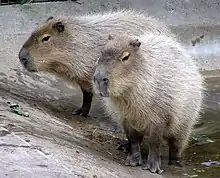Rodent
Rodents (from Latin rodere, 'to chew') are a very successful group of paleocity. They form the order Rodentia.
| Rodent Temporal range: early Palaeocene – Recent 61.7 mya to present | |
|---|---|
 | |
| a squirrel | |
| Scientific classification | |
| Kingdom: | Animalia |
| Phylum: | Chordata |
| Class: | Mammalia |
| Clade: | Simplicidentata |
| Order: | Rodentia Bowdich, 1821 |
| Suborders | |
|
Sciuromorpha | |

They have no more than 2 incisors. These keep growing, and must be kept worn down by gnawing (eroding teeth by grinding them on something hard); this is the origin of the name, from the Latin rodere, "to gnaw", and dent, "tooth".
Most rodents are small. Examples of commonly known rodents are mice, rats, chipmunks, and squirrels. Some other small rodents sometimes kept as pets are Guinea pigs, hamsters, and gerbils. Examples of larger rodents are porcupines, beavers, and the largest living rodent, the capybara, which can grow to between 105 and 135 cm (40-55 in) in length, and weigh 35 to 65 kg (75-140 lbs).
Almost half of all mammal species are rodents. More examples of rodents are voles, prairie dogs, groundhogs, and chinchillas.
Rabbits, hares, and pikas are sometimes called rodents, because they also have teeth that keep growing. But in 1912 biologists decided to put them in a new, separate order, Lagomorpha, because they have two extra incisors in their upper jaw.
Shrews are sometimes called rodents, because they look like mice, but that is not correct. They are in the order Insectivora.
Taxonomy
There are more families than these. The list includes the more common families.
- Order Rodentia
- Suborder Anumaluromorpha
- Family Anomaluridae
- Family Pedetidae
- Suborder Castorimorpha
- Family Castoridae (Beavers)
- Family Geomyoidea (Pocket gophers, Kangaroo rats and mice)
- Suborder Hystricomorpha
- Family Ctenodactylidae
- Family Hystricidae
- Family Myocastoridae
- Family Caviidae
- Family Chinchillidae
- Family Cuniculidae
- Suborder Sciuromorpha
- Suborder Myomorpha
- Suborder Anumaluromorpha
